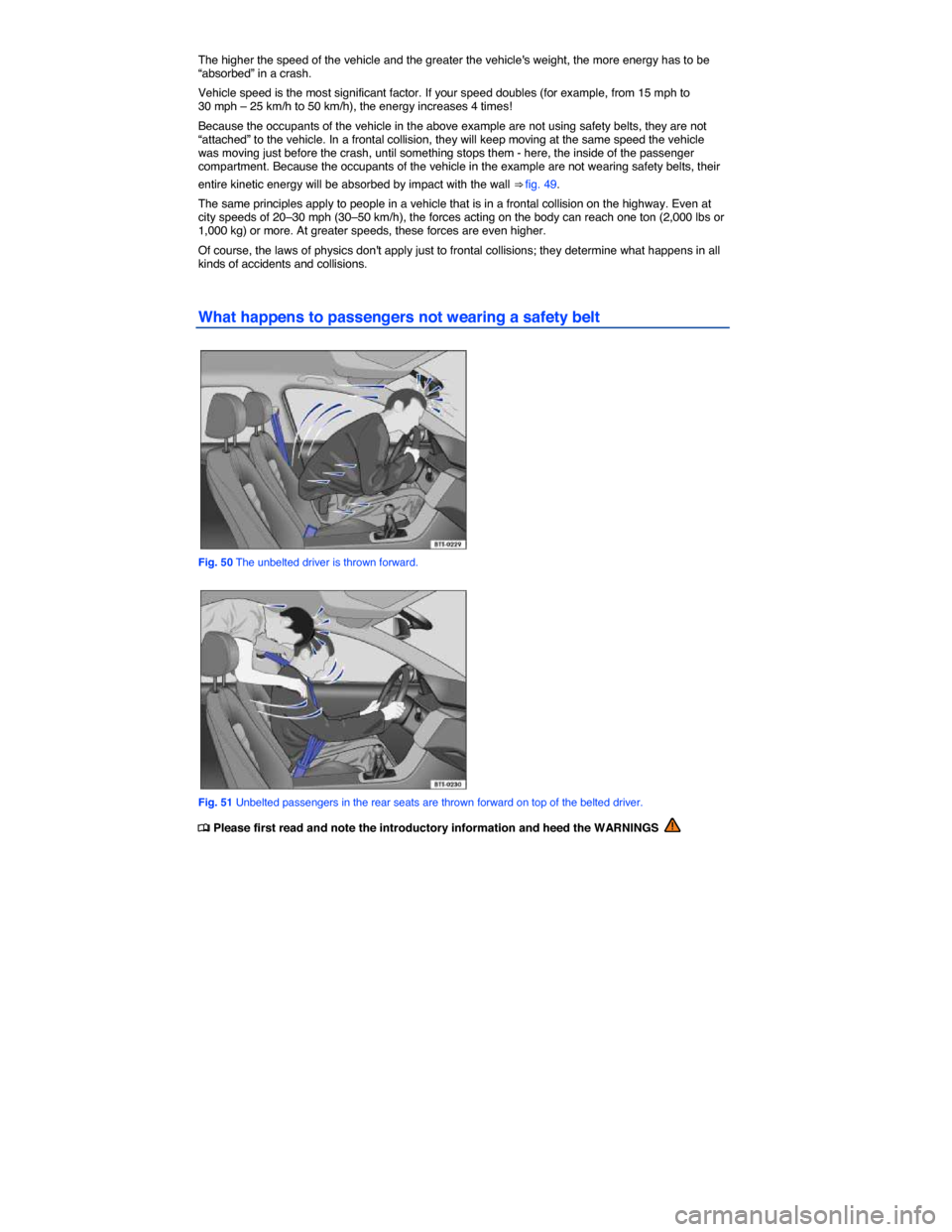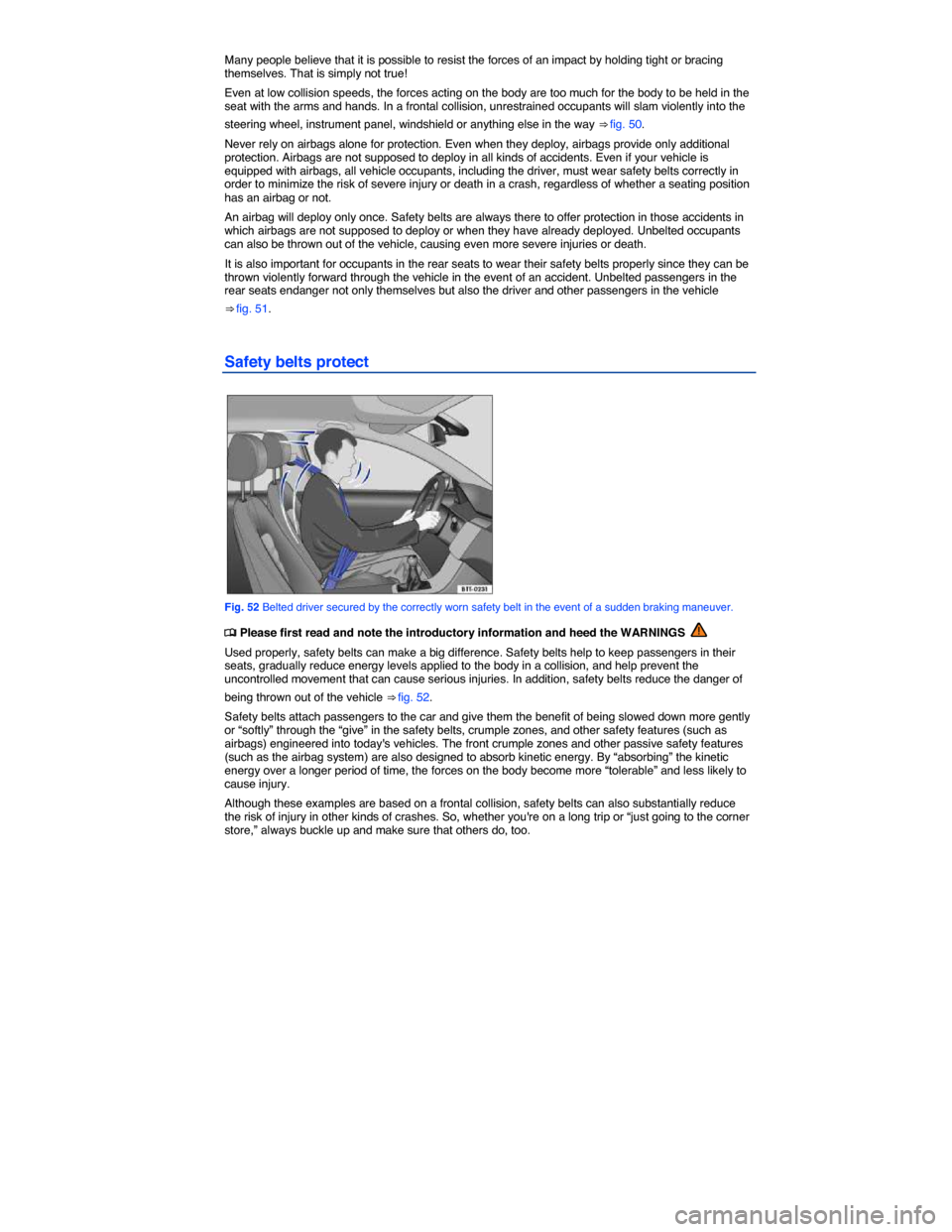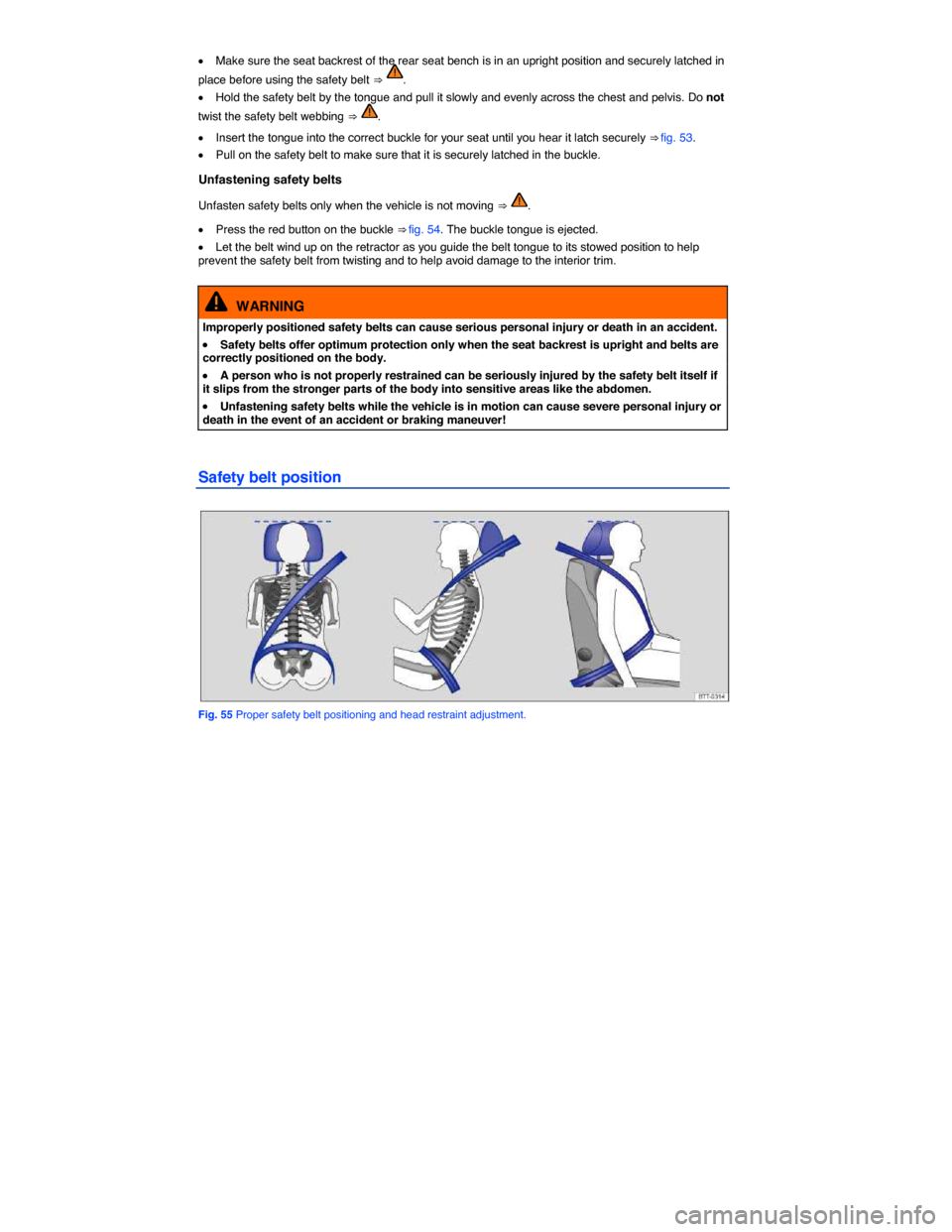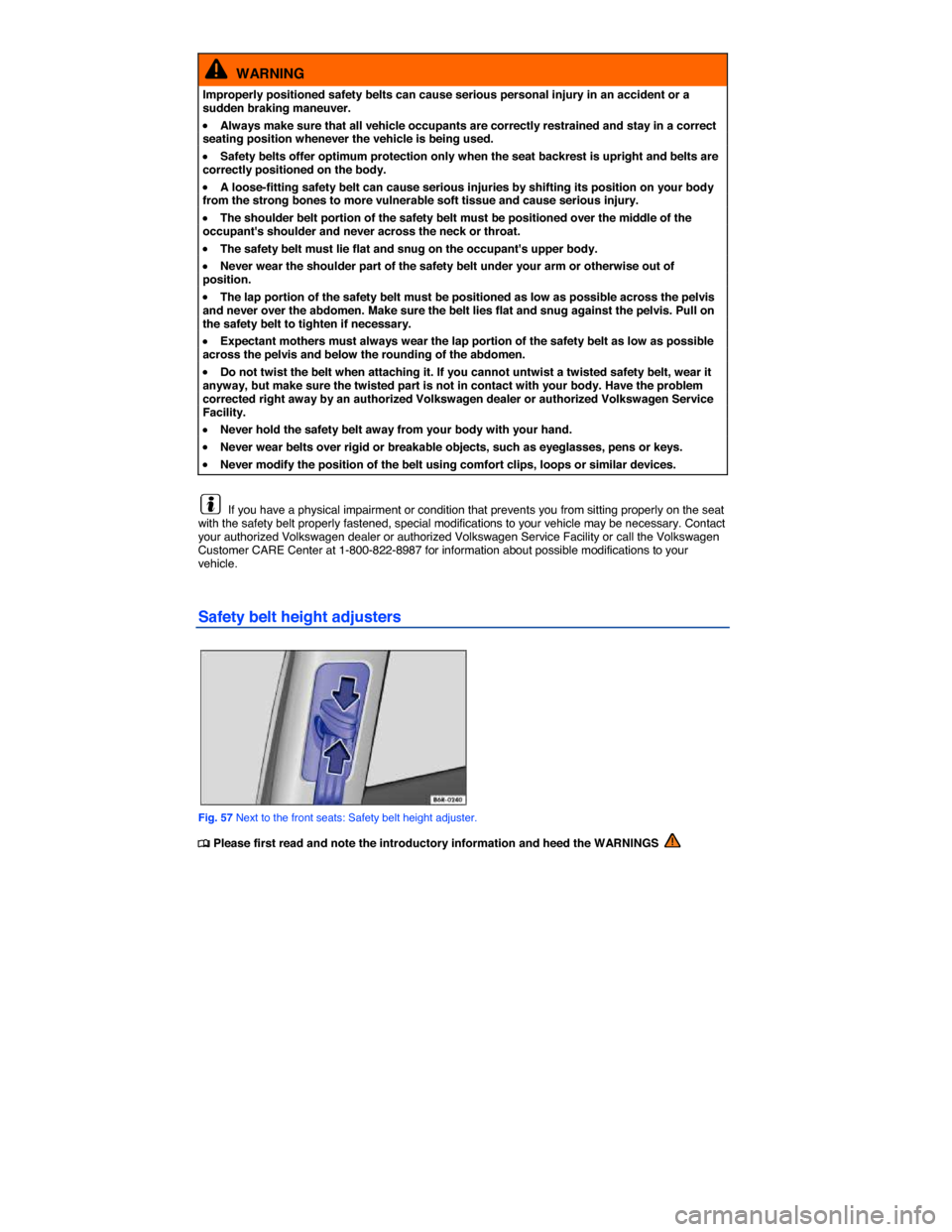Page 82 of 357

The higher the speed of the vehicle and the greater the vehicle's weight, the more energy has to be “absorbed” in a crash.
Vehicle speed is the most significant factor. If your speed doubles (for example, from 15 mph to 30 mph – 25 km/h to 50 km/h), the energy increases 4 times!
Because the occupants of the vehicle in the above example are not using safety belts, they are not “attached” to the vehicle. In a frontal collision, they will keep moving at the same speed the vehicle was moving just before the crash, until something stops them - here, the inside of the passenger compartment. Because the occupants of the vehicle in the example are not wearing safety belts, their
entire kinetic energy will be absorbed by impact with the wall ⇒ fig. 49.
The same principles apply to people in a vehicle that is in a frontal collision on the highway. Even at city speeds of 20–30 mph (30–50 km/h), the forces acting on the body can reach one ton (2,000 lbs or 1,000 kg) or more. At greater speeds, these forces are even higher.
Of course, the laws of physics don't apply just to frontal collisions; they determine what happens in all kinds of accidents and collisions.
What happens to passengers not wearing a safety belt
Fig. 50 The unbelted driver is thrown forward.
Fig. 51 Unbelted passengers in the rear seats are thrown forward on top of the belted driver.
�
Page 83 of 357

Many people believe that it is possible to resist the forces of an impact by holding tight or bracing themselves. That is simply not true!
Even at low collision speeds, the forces acting on the body are too much for the body to be held in the seat with the arms and hands. In a frontal collision, unrestrained occupants will slam violently into the
steering wheel, instrument panel, windshield or anything else in the way ⇒ fig. 50.
Never rely on airbags alone for protection. Even when they deploy, airbags provide only additional protection. Airbags are not supposed to deploy in all kinds of accidents. Even if your vehicle is equipped with airbags, all vehicle occupants, including the driver, must wear safety belts correctly in order to minimize the risk of severe injury or death in a crash, regardless of whether a seating position has an airbag or not.
An airbag will deploy only once. Safety belts are always there to offer protection in those accidents in which airbags are not supposed to deploy or when they have already deployed. Unbelted occupants can also be thrown out of the vehicle, causing even more severe injuries or death.
It is also important for occupants in the rear seats to wear their safety belts properly since they can be thrown violently forward through the vehicle in the event of an accident. Unbelted passengers in the rear seats endanger not only themselves but also the driver and other passengers in the vehicle
⇒ fig. 51.
Safety belts protect
Fig. 52 Belted driver secured by the correctly worn safety belt in the event of a sudden braking maneuver.
�
Page 84 of 357
Accident statistics show that vehicle occupants properly wearing safety belts have a lower risk of being injured and a much better chance of surviving a collision. Properly using safety belts also greatly increases the ability of the supplemental airbags to do their job in a collision. For this reason, wearing a safety belt is required by law in most countries including the United States and Canada.
Although your Volkswagen is equipped with airbags, you still have to wear the safety belts provided. Front airbags, for example, are activated only in some frontal collisions. The front airbags are not activated in all frontal collisions, in side and rear collisions, in rollovers, or in cases when the conditions for deployment stored in the electronic control unit are not met. The same goes for the other airbag systems on your Volkswagen.
So always wear your safety belt and make sure that everybody in your vehicle is properly restrained!
Using safety belts
�
Page 85 of 357
WARNING
Improper use and care of safety belts increases the risk of severe personal injury or death.
�x Regularly check safety belts and related parts for damage.
�x Damaged safety belts must be replaced; they cannot be repaired.
�x Always keep safety belts clean.
�x Never catch, damage or chafe safety belt webbing on sharp edges.
�x Always keep objects and liquids away from the belt buckle and buckle opening.
Fastening and unfastening safety belts
Fig. 53 Inserting the safety belt buckle tongue into the belt buckle.
Fig. 54 Releasing the buckle tongue from the belt buckle.
�
Page 86 of 357

�x Make sure the seat backrest of the rear seat bench is in an upright position and securely latched in
place before using the safety belt ⇒ .
�x Hold the safety belt by the tongue and pull it slowly and evenly across the chest and pelvis. Do not
twist the safety belt webbing ⇒ .
�x Insert the tongue into the correct buckle for your seat until you hear it latch securely ⇒ fig. 53.
�x Pull on the safety belt to make sure that it is securely latched in the buckle.
Unfastening safety belts
Unfasten safety belts only when the vehicle is not moving ⇒ .
�x Press the red button on the buckle ⇒ fig. 54. The buckle tongue is ejected.
�x Let the belt wind up on the retractor as you guide the belt tongue to its stowed position to help prevent the safety belt from twisting and to help avoid damage to the interior trim.
WARNING
Improperly positioned safety belts can cause serious personal injury or death in an accident.
�x Safety belts offer optimum protection only when the seat backrest is upright and belts are correctly positioned on the body.
�x A person who is not properly restrained can be seriously injured by the safety belt itself if it slips from the stronger parts of the body into sensitive areas like the abdomen.
�x Unfastening safety belts while the vehicle is in motion can cause severe personal injury or death in the event of an accident or braking maneuver!
Safety belt position
Fig. 55 Proper safety belt positioning and head restraint adjustment.
Page 87 of 357
Fig. 56 Proper safety belt positioning for expectant mothers.
�
Page 88 of 357

WARNING
Improperly positioned safety belts can cause serious personal injury in an accident or a sudden braking maneuver.
�x Always make sure that all vehicle occupants are correctly restrained and stay in a correct seating position whenever the vehicle is being used.
�x Safety belts offer optimum protection only when the seat backrest is upright and belts are correctly positioned on the body.
�x A loose-fitting safety belt can cause serious injuries by shifting its position on your body from the strong bones to more vulnerable soft tissue and cause serious injury.
�x The shoulder belt portion of the safety belt must be positioned over the middle of the occupant's shoulder and never across the neck or throat.
�x The safety belt must lie flat and snug on the occupant's upper body.
�x Never wear the shoulder part of the safety belt under your arm or otherwise out of position.
�x The lap portion of the safety belt must be positioned as low as possible across the pelvis and never over the abdomen. Make sure the belt lies flat and snug against the pelvis. Pull on the safety belt to tighten if necessary.
�x Expectant mothers must always wear the lap portion of the safety belt as low as possible across the pelvis and below the rounding of the abdomen.
�x Do not twist the belt when attaching it. If you cannot untwist a twisted safety belt, wear it anyway, but make sure the twisted part is not in contact with your body. Have the problem corrected right away by an authorized Volkswagen dealer or authorized Volkswagen Service Facility.
�x Never hold the safety belt away from your body with your hand.
�x Never wear belts over rigid or breakable objects, such as eyeglasses, pens or keys.
�x Never modify the position of the belt using comfort clips, loops or similar devices.
If you have a physical impairment or condition that prevents you from sitting properly on the seat with the safety belt properly fastened, special modifications to your vehicle may be necessary. Contact your authorized Volkswagen dealer or authorized Volkswagen Service Facility or call the Volkswagen Customer CARE Center at 1-800-822-8987 for information about possible modifications to your vehicle.
Safety belt height adjusters
Fig. 57 Next to the front seats: Safety belt height adjuster.
�
Page 89 of 357
Safety belt height adjusters for the front seats can be used to adjust the height of the shoulder portion of the safety belt so that it is positioned correctly:
�x Pinch the safety belt attachment together as indicated by the arrows and hold ⇒ fig. 57.
�x Slide the belt and upper attachment up or down until the safety belt is positioned over the center of the shoulder, Safety belt position.
�x Release the safety belt attachment.
�x Pull on the safety belt to make sure that the upper attachment is securely locked in place.
WARNING
Never adjust the height of the safety belt while driving.
Safety belt extender
Fig. 58 A safety belt extender properly attached to the factory-installed safety belt.
Fig. 59 Positioning of the safety belt extender.
�